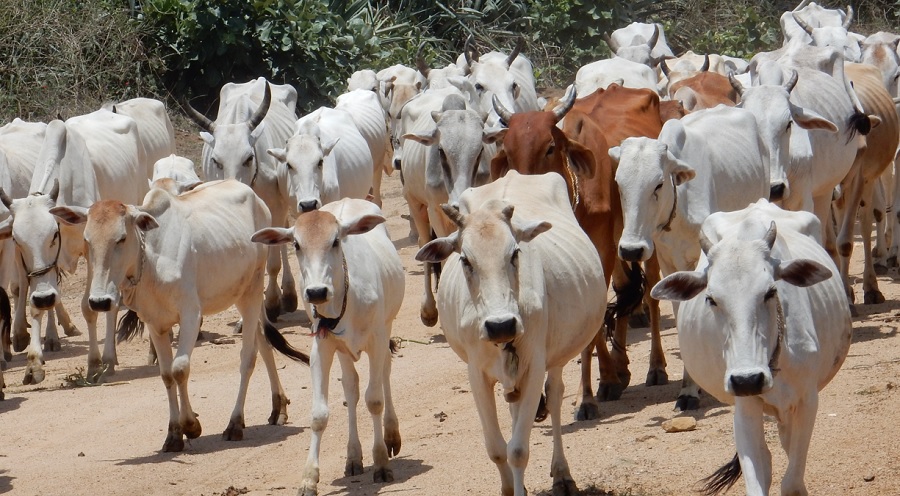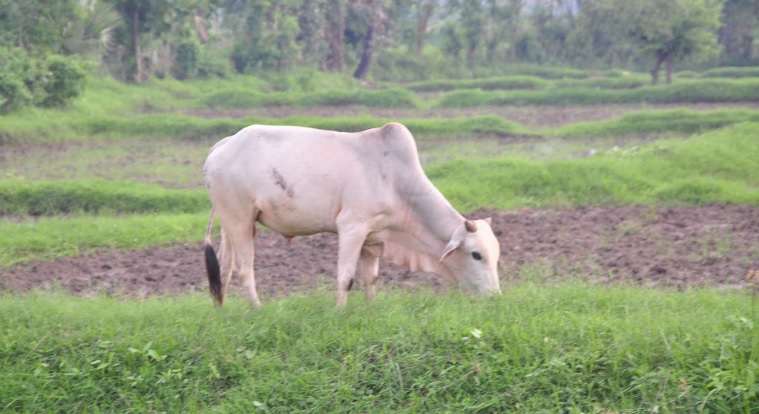
Introduction:
During November 2017 to March 2020, the National Bureau of Animal Genetic Resources (NBAGR), Karnal, Haryana, conducted a survey with the support of BAIF for evaluation and characterization of lesser-known cattle population from Vidarbha region of Maharashtra. The breed registration application was submitted to NBAGR and based on the recommendation of the Animal Husbandry Commissioner, Maharashtra state, these lesser known cattle population known as Kathani cattle, were registered as the 51st cattle breed and the second registered cattle breed from Vidarbha after Gaolao breed.
Breeding area:
The Kathani cattle, found mainly in Gadchiroli, Gondia, and Chandrapur districts were surveyed. The breeding area is highlighted in the map below.

Feed and fodder resources:
It was observed that Tanis (after harvest leftover of paddy), Kadaba (dry jowar), Kutar (leftover of soybean, mung, wheat, cowpea, chickpea, pigeon pea and black gram) and grasses were the major fodder available for the Kathani breed. As mono cropping (paddy, soybean, tur, chickpea) based on rain-fed irrigation was practiced, in the absence of green fodder, Kukus (crushed home-made rice bran), kukus pani, kukus dana, kukus dhep and kukus pith were provided to the animals as concentrate feed.

Traditional Practices:
Dongi: The laboratory proximate feed and fodder analysis revealed that Kathani animals were being reared on very low nutritive value content fodder. Inspite of feed and fodder deficiency, the farmers refrained from providing commercial mineral supplement to their animals. However, stale food, curry and hand washed water were stored in a vessel made of either wood, stone or cement concrete and locally known as ‘Dongi’ with a capacity of 8 to 10 litres and mixed with some quantity of kukus and fed to working bullocks and milking cows the next day in the morning.

Grazing of Animals in groups: The unique practice of group grazing was followed for Kathani cattle which was attributed to the availability of open grazing land especially in forest areas and work force for grazing the animals which led to a zero-input system and whatever was earned from animals like limited milk and manure and bullock power for agriculture resulted in surplus income for the cattle owners.

Aakhar / Gohan: A common place – Aakhar / Gohan where all the animals collect prior to grazing generally owned by the Gram Panchayat or belonging to the forest department measures one to one and a half acres and accommodates 80 to 100 animals of different age groups and are found in every village. The cow herder locally known as Gayaki waits for one and a half to two hours in this Aakhar till all the animals gather. The cow herder maintains a record of the cattle owner and the number of animals he is taking for grazing. The farmers start bringing their animals from 7 am onwards and remain up to 10 am. During this time, dung defecated by the animals becomes the property of the cow herder along with the responsibility of general cleaning of the place. The dung collected is sold as manure to interested farmers. After grazing in the evening time, when the animals return, they directly go to their respective owner’s house.
Gayaki: The cow herder (Gayaki) is generally illiterate or has received education only up to the 2nd or 3rd standard. One Gayaki takes 50 to 60 animals for common grazing and if the number of animals increases, then more than one person is involved to take care of the animals. The animal owner has to pay a certain fee per month for grazing of adult animals while suckling calves and animals below one year of age are not charged. Along with this token amount, in some parts, paddy is also given to the Gayaki. In his absence, he arranges for a substitute cow herder. The cow herder is rewarded (Bojara) in cash or kind and some token amount is also paid during festivals such as Deepawali. The Gayaki visits every owner and collects this Bojara once a year. They have to walk on an average 8 to 10 km behind the animals depending on the availability of grazing land and drinking water for the animals. If during grazing, any incident such as natural service, delivery, attack by wild animals and cases of animals going missing occurs, it is his responsibility to inform the cattle owner. This source of livelihood lasts only 10 months in a year from June to March and in the months of April and May, animals cannot be grazed as agricultural fields are left fallow.

Constraints of Gayakis: During discussions with some of the cow herders (Gayakis) engaged in this business for more than nine to ten years, it was realized that declining grazing land compels them to walk more distance behind the animals, fear of attack by wild animals such as tiger, wolf and bear, sudden abnormal behavior of animals which makes it difficult to control them, irregular payment from cattle owners, free of cost rearing of animals below one year of age, scarcity of drinking water for animals especially in summer resulting in covering a longer distance in search of water and difficulty in getting a substitute during illness were some of the serious constraints.
Constraints of animal owners: Animal owners also have their own constraints as in the absence of cow herder as the youth of today are not interested in this unreliable source of livelihood, they are forced to reduce the size of their herd and with low economic value of non-descript animals, their cash flow is poor and hence, they are unable to ensure regular payment of the Gayakis on time apart from rain-fed mono cropping pattern resulting in fodder shortage, lower market value of animals subsequent to the ban on animal slaughter and animal race.
Alternatives: The cattle owners in every village have formed 1 or 2 groups to take care of their animals. Four to six cattle owners form a group with 60 to 80 animals and every day, two owners take care of all the animals for two days and for the next two days, two other owners function as Gayakis.
Gedaga / Badaga: The normal age of the animal when they are put to agriculture work for the first time is around 3.5 to 4 years. A wooden two-piece ‘T’ shaped structure called Gedaga or Badaga in the local language is fitted on the neck of a bull calf who will serve as a bullock in the future. This helps to train such calves as psychologically he realized that he has to carry a load of such type. The weight of the Gedaga is around 5 to 7 kg and made from palas tree (Butea monosperma). This Gedaga is kept on the neck of the animals for 15 days which generates a feeling of yoke for the calf. Farmers find this technique easy to train bulls for agriculture work.


Dr. R. L. Bhagat
Senior Thematic Program Executive
BAIF, CRS, Uruli Kanchan, Pune

you are truly a just right webmaster The site loading speed is incredible It kind of feels that youre doing any distinctive trick In addition The contents are masterwork you have done a great activity in this matter
Somebody essentially help to make significantly articles Id state This is the first time I frequented your web page and up to now I surprised with the research you made to make this actual post incredible Fantastic job